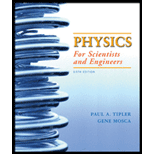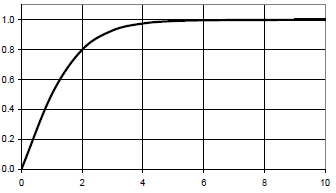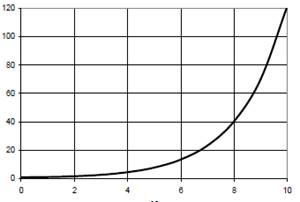
Concept explainers
(a)
Speed of the spaceship in frame
(a)
Explanation of Solution
Given:
Spaceship that is at rest in frame
Spaceship is given further boost 2 of
Process is continued indefinitely at
Formula used:
Write the expression of equation for relativistic velocity addition
Here,
Simplify the above expression
Calculation:
Substitute 0 for
For rest of the values of
| Number of boosts | Speed after |
| 2 | 0.800 |
| 3 | 0.929 |
| 4 | 0.976 |
| 5 | 0.992 |
| 6 | 0.997 |
| 7 | 0.999 |
| 8 | 1.000 |
| 9 | 1.000 |
| 10 | 1.000 |
Draw a diagram to plot the speed in units of

Conclusion:
Thus, the speed is calculated and represented graphically as a function of number of boosts.
(b)
Graphical representation of gamma factor.
(b)
Explanation of Solution
Given:
Spaceship that is at rest in frame
Spaceship is given further boost 2 of
Process is continued indefinitely at
Formula used:
Write the expression of gamma factor
Here,
Calculation:
Substitute 0 for
For rest of the values of
| Number of boosts | Gamma factor after |
| 1 | 1.15 |
| 2 | 1.67 |
| 3 | 2.69 |
| 4 | 4.56 |
| 5 | 7.83 |
| 6 | 13.52 |
| 7 | 23.39 |
| 8 | 40.51 |
| 9 | 70.15 |
| 10 | 121.50 |
Draw a diagram to plot the gamma factor along

Conclusion:
Thus, the gamma factor is calculated and represented graphically as a function of number of boosts.
(c)
Number of required boosts until speed of ship in
(c)
Explanation of Solution
Introduction:
A spaceship that is at rest in frame
The graph of the speed after
Conclusion:
Thus, the number of required boosts until speed of ship in
(d)
Distance traveled by spaceship as well as average speed of spaceship between boost 1 and boost 6 in frame
(d)
Explanation of Solution
Given:
Spaceship that is at rest in frame
Spaceship is given further boost 2 of
Process is continued indefinitely at
Formula used:
Write the expression of distance traversed by spaceship between boosts 1 and 6 in frame
Write the expression for elapsed time between boosts 1 and 6 in frame
Write the expression for average speed of spaceship in frame
Calculation:
Substitute
Substitute
Conclusion:
Thus, the distance traveled by spaceship is
Want to see more full solutions like this?
Chapter 39 Solutions
EBK PHYSICS FOR SCIENTISTS AND ENGINEER
- Required information Two speakers vibrate in phase with each other at 523 Hz. At certain points in the room, the sound waves from the two speakers interfere destructively. One such point is 1.45 m from speaker #1 and is between 2.00 m and 4.00 m from speaker #2. The speed of sound in air is 343 m/s. How far is this point from speaker #2? marrow_forwarda) Consider the following function, where A is a constant. y(x,t) = A(x — vt). Can this represent a wave that travels along? Explain. b) Which of the following are possible traveling waves, provide your reasoning and give the velocity of the wave if it can be a traveling wave. e-(a²x²+b²²-2abtx b.1) y(x,t) b.2) y(x,t) = = A sin(ax² - bt²). 2 b.3) y(x,t) = A sin 2π (+) b.4) y(x,t) = A cos² 2π(t-x). b.5) y(x,t) = A cos wt sin(kx - wt)arrow_forwardThe capacitor in (Figure 1) is initially uncharged. The switch is closed at t=0. Immediately after the switch is closed, what is the current through the resistor R1, R2, and R3? What is the final charge on the capacitor? Please explain all steps.arrow_forward
- Suppose you have a lens system that is to be used primarily for 620-nm light. What is the second thinnest coating of fluorite (calcium fluoride) that would be non-reflective for this wavelength? × nm 434arrow_forwardThe angle between the axes of two polarizing filters is 19.0°. By how much does the second filter reduce the intensity of the light coming through the first? I = 0.106 40 xarrow_forwardAn oil slick on water is 82.3 nm thick and illuminated by white light incident perpendicular to its surface. What color does the oil appear (what is the most constructively reflected wavelength, in nanometers), given its index of refraction is 1.43? (Assume the index of refraction of water is 1.33.) wavelength color 675 × nm red (1 660 nm)arrow_forward
- A 1.50 μF capacitor is charging through a 16.0 Ω resistor using a 15.0 V battery. What will be the current when the capacitor has acquired 1/4 of its maximum charge? Please explain all stepsarrow_forwardIn the circuit shown in the figure (Figure 1), the 6.0 Ω resistor is consuming energy at a rate of 24 J/s when the current through it flows as shown. What are the polarity and emf of the battery E, assuming it has negligible internal resistance? Please explain all steps. I know you need to use the loop rule, but I keep getting the answer wrong.arrow_forwardIf you connect a 1.8 F and a 2.6 F capacitor in series, what will be the equivalent capacitance?arrow_forward
- Suppose that a particular heart defibrillator uses a 1.5 x 10-5 Farad capacitor. If it is charged up to a voltage of 7300 volts, how much energy is stored in the capacitor? Give your answer as the number of Joules.arrow_forwardThe voltage difference across an 8.3 nanometer thick cell membrane is 6.5 x 10-5volts. What is the magnitude of the electric field inside this cell membrane? (Assume the field is uniform, and give your answer as the number of Volts per meter... which is the same as the number of Newtons per Coulomb.)arrow_forwardThree identical capacitors are connected in parallel. When this parallel assembly of capacitors is connected to a 12 volt battery, a total of 3.1 x 10-5 coulombs flows through the battery. What is the capacitance of one individual capacitor? (Give your answer as the number of Farads.)arrow_forward
 Principles of Physics: A Calculus-Based TextPhysicsISBN:9781133104261Author:Raymond A. Serway, John W. JewettPublisher:Cengage Learning
Principles of Physics: A Calculus-Based TextPhysicsISBN:9781133104261Author:Raymond A. Serway, John W. JewettPublisher:Cengage Learning Modern PhysicsPhysicsISBN:9781111794378Author:Raymond A. Serway, Clement J. Moses, Curt A. MoyerPublisher:Cengage Learning
Modern PhysicsPhysicsISBN:9781111794378Author:Raymond A. Serway, Clement J. Moses, Curt A. MoyerPublisher:Cengage Learning University Physics Volume 3PhysicsISBN:9781938168185Author:William Moebs, Jeff SannyPublisher:OpenStax
University Physics Volume 3PhysicsISBN:9781938168185Author:William Moebs, Jeff SannyPublisher:OpenStax Physics for Scientists and Engineers: Foundations...PhysicsISBN:9781133939146Author:Katz, Debora M.Publisher:Cengage Learning
Physics for Scientists and Engineers: Foundations...PhysicsISBN:9781133939146Author:Katz, Debora M.Publisher:Cengage Learning Classical Dynamics of Particles and SystemsPhysicsISBN:9780534408961Author:Stephen T. Thornton, Jerry B. MarionPublisher:Cengage Learning
Classical Dynamics of Particles and SystemsPhysicsISBN:9780534408961Author:Stephen T. Thornton, Jerry B. MarionPublisher:Cengage Learning





